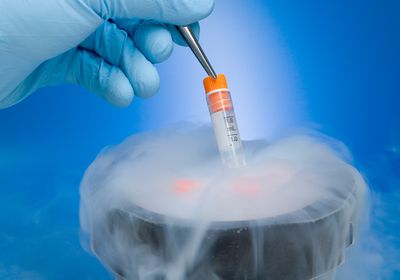ABOVE: Biobanks provide a convenient option for sample collection and storage in cancer research. ©istock, dra_schwartz
A biobank is a specialized repository that facilitates systematic collection, storage, and management of a wide variety of biological samples, such as tissues, blood, DNA, and other biomaterials, along with associated clinical and demographic information from individuals. These samples are preserved under controlled conditions, often at extremely low temperatures, to maintain their integrity for future research and medical purposes. Biobanks play a crucial role in biomedical research by providing a valuable resource of well-annotated biospecimens for studying diseases, understanding their underlying mechanisms, and developing personalized treatments.1-4
The roots of biobanking can be traced back to early scientific endeavors to understand human biology and disease. From ancient anatomical collections to early tissue preservation methods, humans practiced the systematic collection and storage of biological specimens for centuries, albeit in rudimentary forms. However, in the mid-20th century, the rapid progress in genetics, molecular biology, and medical diagnostics highlighted the need for structured repositories of biological samples. Scientists and clinicians realized that to unlock the mysteries of diseases like cancer, they needed access to diverse and well-annotated specimens. This realization marked the birth of modern biobanking practices.
Challenges in Cancer Research: The Need for Biobanks
In the mid-20th century, cancer, with its complex etiology and diverse manifestations, posed formidable challenges to researchers and clinicians. Traditional approaches to studying cancer often fell short in capturing the intricacies of the disease at a molecular level due to the paucity of collected tumor samples both in terms of quantity and standardized annotation. This variability and scarcity hindered comprehensive research efforts and hindered progress in understanding cancer's complexities.5,6
The availability of well-annotated biobanked samples allowed researchers to correlate genetic and molecular data with clinical outcomes, identify biomarkers, and study disease progression.7,8 The advent of precision medicine marked a paradigm shift in cancer care, moving away from a one-size-fits-all approach to a tailored, patient-centric model. At the core of precision oncology is the integration of genetic, molecular, and clinical data to guide personalized treatment strategies. This approach recognizes that each patient's cancer is unique, influenced by genetic variations, environmental factors, and lifestyle choices.
Biobanks play a pivotal role in precision oncology by providing the biological samples necessary for molecular profiling and biomarker discovery. By analyzing the genetic and molecular characteristics of tumors, clinicians can identify actionable mutations and select targeted therapies that are most likely to be effective for each patient. 9–12 This targeted approach minimizes the risks of ineffective treatments and reduces potential side effects.
Multiomics Meets Biobanking to Accelerate Cancer Research
The process of biomarker discovery involves large-scale data analysis, collaboration between multidisciplinary teams, and validation studies—an inconvenience of the past which is now facilitated via biobanks.
Recently, the integration of multiomics data has emerged as a cornerstone of contemporary cancer research. By simultaneously analyzing genomics, transcriptomics, proteomics, metabolomics, and epigenomics data, researchers gain a comprehensive understanding of cancer biology and its heterogeneity.13,14 This holistic approach considers the complex interactions between genes, proteins, metabolites, and regulatory elements that drive cancer progression.
Biobanks provide the biological specimens essential for multiomics analysis, fueling discoveries in cancer pathogenesis and therapeutic targets. For instance, genomic data obtained from biobanked samples can identify genetic mutations associated with cancer subtypes or drug resistance. Transcriptomic analysis reveals gene expression patterns that may indicate disease aggressiveness or response to immunotherapy. Proteomic and metabolomic profiling offer insights into cellular pathways and metabolic alterations in cancer cells.
Integrating data from different omics layers allows researchers to uncover novel biomarkers, identify druggable targets, and predict treatment outcomes.11,12,15-17
Biobanking Ethics and Regulatory Considerations
As biobanking evolves, ethical and regulatory considerations take center stage with patient privacy, informed consent, and data security being paramount. Collaborative efforts between biobanks, research institutions, and regulatory bodies are crucial in establishing guidelines that uphold ethical standards while fostering scientific progress.18,19
Ethical considerations also extend to data sharing and collaboration. Biobanks often collaborate with research institutions and pharmaceutical companies to share samples and data for collaborative research projects. However, biobankers must ensure that data sharing is conducted ethically, with proper consent and data anonymization, to protect patient rights and privacy.20
As biobanks operate on a global scale, harmonizing ethical standards and regulatory frameworks across different jurisdictions is critical. International collaborations and guidelines, such as those provided by organizations like the World Health Organization and the International Society for Biological and Environmental Repositories, will help promote ethical biobanking practices.21,22
The Future of Biobanking
The future of biobanking in precision oncology relies on technological advancements, data integration, and international collaboration. Innovations such as AI-driven data analytics, blockchain technology for secure data sharing, and miniaturized biosensors hold promise in enhancing biobanking capabilities. Moreover, initiatives promoting global data sharing and harmonization will accelerate discoveries and improve patient outcomes.
Innovations in sample collection and storage, such as liquid biopsies and cryopreservation techniques, will expand the range of samples available for research. These advancements will enable researchers to access real-time molecular data and monitor disease progression longitudinally. Additionally, advancements in data analytics, including machine learning algorithms and predictive modeling, will aid in extracting meaningful insights from large-scale omics datasets.
International collaboration and data sharing initiatives will continue to shape the landscape of biobanking and precision oncology. Collaborative networks, data commons, and shared repositories will facilitate data exchange, cross-validation of findings, and meta-analyses. These efforts will lead to the development of robust biomarkers, predictive models, and personalized treatment strategies that benefit patients worldwide.
References
1. Carey DJ, et al. The Geisinger MyCode Community Health Initiative: an electronic health record-linked biobank for precision medicine research. Genet Med. 2016;18(9):906-13.
2. Malsagova K, et al. Biobanks—A platform for scientific and biomedical research. Diagnostics. 2020;10(7).
3. Coppola L, et al. Biobanking in health care: Evolution and future directions. J Transl Med. 2019;17(1):172.
4. Hewitt R, et al. Defining biobank. Biopreserv Biobank. 2013;11(5):309-15.
5. Annaratone L, et al. A collection of primary tissue cultures of tumors from vacuum packed and cooled surgical specimens: A feasibility study. PLoS one. 2013;8(9):e75193.
6. Zatloukal K, et al. Human tissue biobanks as instruments for drug discovery and development: Impact on personalized medicine. Biomark Med. 2010;4(6):895-903.
7. Annaratone L, et al. Basic principles of biobanking: From biological samples to precision medicine for patients. Virchows Arch. 2021;479(2):233-46.
8. Cervo S, et al. Drafting biological material transfer agreement: A ready-to-sign model for biobanks and biorepositories. Int J Biol Markers. 2016;31(2):e211-7.
9. Ballester PJ, et al. Artificial intelligence for the next generation of precision oncology. Npj Precis Onc. 2021;5(1):79.
10. Capocasa M, et al. Samples and data accessibility in research biobanks: An explorative survey. PeerJ. 2016;4:e1613.
11. Kinkorová J. Biobanks in the era of personalized medicine: Objectives, challenges, and innovation. EPMA J. 2016;7:4.
12. Liu A, et al. Biobanking for personalized medicine. Advin Expmed Bio. 2015;864:55-68.
13. Chakraborty S, et al. Onco-multi-omics approach: A new frontier in cancer research. Biomed Res Int. 2018;2018(1):9836256.
14. Manzoni C, et al. Genome, transcriptome and proteome: The rise of omics data and their integration in biomedical sciences. Brief Bioinfor. 2018;19(2):286-302.
15. Heo YJ, et al. Integrative multi-omics approaches in cancer research: From biological networks to clinical subtypes. Mol Cells. 2021;44(7):433-443.
16. Biswas N, et al. Artificial intelligence (AI)-based systems biology approaches in multi-omics data analysis of cancer. Front Oncol. 2020;10:588221.
17. Mendy M, et al. Common minimum technical standards and protocols for biobanks dedicated to cancer research. IARC Technical Publications. Lyon (FR)2017.
18. Qualman SJ, et al. Establishing a tumour bank: Banking, informatics and ethics. Br J Cancer. 2004;90(6):1115-1119.
19. Vaught J, et al. A review of international biobanks and networks: Success factors and key benchmarks. Biopreserv Biobank. 2009;7(3):143-150.
20. Patil S, et al. Cancer oriented biobanks: A comprehensive review. Oncol Rev. 2018;12(1):357.
21. Ambrosone CB, et al. Establishing a cancer center data bank and biorepository for multidisciplinary research. Cancer Epidemiol Biomarkers Prev. 2006;15(9):1575-1577.
22. Peakman T, Elliott P. Current standards for the storage of human samples in biobanks. Genome Med. 2010;2(10):72.




